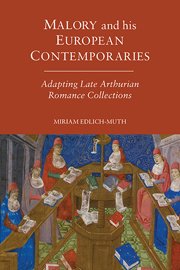Book contents
- Frontmatter
- Dedication
- Contents
- Colophon
- Acknowledgements
- Introduction
- 1 The Adaptation Process
- 2 Style and Narrative Strategy
- 3 Chronological and Genealogical Structures in the Morte Darthur, the Buch der Abenteuer and the Tavola Ritonda
- 4 Narrative Plot Development in the Morte Darthur, the Buch der Abenteuer and the Tavola Ritonda
- 5 ‘The Best Knight in the World’: Adapting Character Constellations
- Conclusion
- Appendix: Note on the Texts and Manuscripts
- Bibliography
- Index
- Arthurian Studies
3 - Chronological and Genealogical Structures in the Morte Darthur, the Buch der Abenteuer and the Tavola Ritonda
Published online by Cambridge University Press: 05 March 2014
- Frontmatter
- Dedication
- Contents
- Colophon
- Acknowledgements
- Introduction
- 1 The Adaptation Process
- 2 Style and Narrative Strategy
- 3 Chronological and Genealogical Structures in the Morte Darthur, the Buch der Abenteuer and the Tavola Ritonda
- 4 Narrative Plot Development in the Morte Darthur, the Buch der Abenteuer and the Tavola Ritonda
- 5 ‘The Best Knight in the World’: Adapting Character Constellations
- Conclusion
- Appendix: Note on the Texts and Manuscripts
- Bibliography
- Index
- Arthurian Studies
Summary
One of the things the writers of late Arthurian collections have in common is that they all base their work on an already rich tradition that had blossomed centuries earlier. These writers therefore needed to combine a wide range of source materials from different traditions and in different languages, most notably French and other vernaculars. Given the popularity of Arthurian stories in the thirteenth century, the tales would have been familiar to a large proportion of their audience, making it necessary for later adaptors to remain close to their source material. As Jane Taylor puts it:
Writer and reader […] are assumed to share a rudimentary knowledge at least of Arthurian chronology […]: advent, development, apogee and fall. In broad outline, therefore, this chronology must remain sacrosanct; insertion of new material can be narratively convincing […] only if the process involves no radical disturbance to this elementary but immutable scheme.
In addition to this, the authors also needed to reconcile contradictions between sources, and above all to create a plausible time structure within which to accommodate all the adventures they wished to include.
Taking the Buch and the Morte as two very different examples of particularly late chronographies, this chapter compares the representation of time in these works to the more elaborate descriptive contextualisation of the Lancelot–Grail cycle, which is a common indirect source of both works.
- Type
- Chapter
- Information
- Malory and his European ContemporariesAdapting Late Arthurian Romance, pp. 62 - 86Publisher: Boydell & BrewerPrint publication year: 2014



